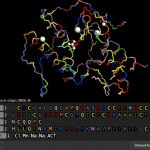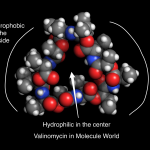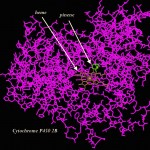Chemistry & Biochemistry
Imagine a simple hike in a grassy part of South America. You hear a rattle and feel a quick stab of pain as fangs sink into your leg. Toxins in the snake venom travel through your blood vessels and penetrate your skin. If the snake is a South American rattlesnake, Crotalus terrific duressis, one of those toxins will be a phospholipase. Phospholipases attack cell and mitochondrial membranes destroying nerve and muscle function. Without quick treatment, a snakebite victim may be die or suffer permanent damage (1, 2).
The phospholipase from…
When finding a female scientists' data turns into an archeological treasure hunt.
A few months ago, I decided it would be interesting to celebrate various scientific contributions by making images of chemical / molecular structures in the Molecule World iPad app and posting them on Twitter (@MoleculeWorld). Whenever I can, I like to highlight scientific contributions from women on their birthdays. Tomorrow's post will feature Dr. Isabella Karle, an x-ray crystallographer who worked on the Manhattan project and solved structures of interesting molecules like…
On pinene and inhibiting enzymes.
People of a certain age may remember a series of really funny commercials featuring Euell Gibbons and his famous question about whether you've ever eaten a pine tree. "Some parts are edible" said Euell.
Perhaps some parts are, but other pine tree products aren't so nourishing. Crystallography365, aka @Crystal_in_city had a couple of fun blog posts about pinene, a chemical made by pine trees, that also inhibits cytochrome P450 2B6.
I was inspired by their posts and by my experience with Cytochrome P450 to go a little…
It's a long, long, weekend; perfect for going outside and doing a few loud, messy experiments. Cooking-intensive holidays always remind me how much fun it is to do a bit of chemistry, especially when it comes to food.
If you watched the video that I posted on Thanksgiving, you've probably been itching to try one of these experiments yourself.
Some chemistry experiments are better in the spring, especially if you're using peeps, but experiments with candy and soda pop can happen anytime.
If you'd like to give these sorts of experiments a try, the Disgruntled Chemist posted a truly…
If you're not cooking today, why not experiment? Here's something fun you can do with Mentos and Diet Coke - and for those of you who think these experiments are too messy, you can still watch the movie.
Enjoy the music in the video, then go outside, and enjoy the show. Later, go to EepyBird.com and learn about the science behind the fountain effect.
technorati tags: Mentos and Diet Coke, chemistry, science you can do at home
Our household is very excited about Thanksgiving.
That's because this Thanksgiving, my husband is cooking a turkey in an egg. A big green egg.
Check back later today, about 5:30 pm, Pacific Standard Time, to see a picture of the turkey. In the meantime, here are some other items that were cooked in the egg.
We've had:
Ribs
Fish
Zucchini
Pizza
If you can cook it in an egg, he will try it.
I used to be the primary cook in our house, but that's all changed since we got the egg. Now, my husband cooks everything, just to see how it will work.
But, now I've learned from Make…
Before mammals, before dinosaurs, before bacteria, or plants, there was something else; a protocell containing RNA.
The Exploring Origins Project has excellent animations of protocells, a timeline of life's evolution, and best of all- fantastic animations of the RNA world.
You can see how RNA folds, ribozymes (RNA that catalyzes chemical reactions), and learn about the role of RNA when the Earth was young.
BTW- I made this ribozyme image with Cn3D. The RNA is synthetic - made by humans with machines, that is, and this molecule can cut chemical bonds.
Want to learn more about Parkinson's disease? See why a single nucleotide mutation messes up the function of a protein?
I have a short activity that uses Cn3D (a molecular viewing program from the NCBI) to look at a protein that seems to be involved in a rare form of Parkinson's disease and I could sure use beta testers.
If you'd like to do this, I need you to follow the directions below and afterwards, go to a web form and answer a few questions. Don't worry about getting the wrong answers. I won't know who you are, so I won't know if you answered anything wrong.
If you have any concerns…
The Periodic Table of Videos from the University of Nottingham has 118 short YouTube clips about the elements. Wired Campus recommended the Sodium clip (below). I liked it, too. It's not quite as funny as Mentos in Diet Coke, and but it's still cute and the narrator has a haircut like Gene Wilder in Young Frankenstein.
H/T: Wired Campus.
Instead of enjoying a sunny summer day today, or partying with SciBlings in New York, I'm staring out my window watching the rain. Inspiration hit! What about searching for August?
Folks, meet the HFQ protein from E. coli. I found this lovely molecule by doing a multi-database search at the NCBI with the term 'August'.
HFQ is a lovely protein with six identical subunits, that's involved in processing small RNA molecules and is homologous to some eucaryotic proteins that work in RNA splicing (1).
Do you see the blue loopy regions in the center of the structure? Those are positively…
APRIL was so much fun, that I thought I should find a molecule for May. I searched both the Gene database, the structure database, everywhere, without any luck.
Finally, I decided to change the search and use the date instead of the name of the month. And here we have it, straight from PubChem. A molecule for May. 05012008 is the compound substance ID.
5/1/2008 Update:
This structure turned out to be a bit surprising. Not does it look highly reactive, it also seems to disappear in the PubChem database. Sometimes I can find it by using the SID, sometimes I can't. I hate that.
For those of…
Over 2600 genetic diseases have been found where a change in a single gene is linked to the disease. One of the questions we might ask is how those mutations change the shape and possibly the function of a protein?
If the structures of the mutant and wild type (normal) proteins have been solved, NCBI has a program called VAST that can be used to align those structures. I have an example here where you can see how a single amino acid change makes influenza resistant to Tamiflu®.
This 4 minute movie below shows how we can obtain those aligned structures from VAST and view them with Cn3D.…
I love using molecular structures as teaching tools. They're beautiful, they're easy to obtain, and working with them is fun.
But working with molecular structures as an educators can present some challenges. The biggest problem is that many of the articles describing the structures are not accessible, particularly those published by the ACS (American Chemical Society). I'm hoping that the new NIH Open Access policy will include legacy publications and increase access to lots of publications about structures.
It would also be great if other funding agencies, like the National Science…
This morning I had a banana genome, an orange genome, two chicken genomes (haploid, of course), and some fried pig genome, on the side. Later today, I will consume genomes from different kinds of green plants and perhaps even a cow or fish genome. I probably drank a bit of coffee DNA too, but didn't consume a complete coffee genome since my grinder isn't that powerful and much of the DNA would be trapped inside the ground up beans.
Of course, microbes have genomes, too. But I do my best to cook those first.
So, what is a genome? Is it a chromosome? Is it one of those DNA fragments or…
How do you go about researching a genetic disease?
This multi-part series explores how digital resources can be used to learn about Huntingtin's disease. Reposted and updated from the original DigitalBio.
A bit of background
Alice's Restaurant is a movie with an unforgettable song that mostly revolves around Arlo Guthrie hanging out with his friends. Somewhere in the movie, the conversation turns to Woody, and someone asks the question that no one wants to touch. Does Arlo's girlfriend know about Huntington's? ...dead silence... Now, I did see the movie quite a few years ago, so my…
This is a fun puzzle. The pink molecule is a protein and the other molecule is a nucleic acid.
If I gave you the amino acid sequence of this protein, or the nucleotide sequence of this nucleic acid, what is the probability of finding a similar sequence in a different species (picked at random)?
A. High
B. Medium
C. Low
D. It depends on the database that you're searching.
You can have more than one answer.
Now, here's the hard part. Explain why you think your answer is correct.
How do you use science outside of the lab?
People say that transferring knowledge and skills from one subject to another represents one of the highest levels of learning. They also say that it hardly ever happens. Perhaps this explains some of the more astounding things that we hear from Nobel Prize winners, like when Francis Crick proposed that Earth was settled by sperm from outer space, or when Watson, well, we'll leave that subject alone for now.
I admit, I don't always think to apply my scientific training to things that happen outside of the lab. When those moments do happen, I relish…
The grocery store magazine covers all say that home made gifts are big this year. So I thought, some of you might like to channel your inner Martha Stewart and make gifts with a science theme.
I'm here to help to you make a merry mug with one of our favorite molecules. Yep, we're talking caffeine.
1. First, we'll go to PubChem at the NCBI. It's not an exclusive (or even last) resort but there are lots of fancy molecules hanging around, just waiting to be discovered and put onto drinking containers.
2. Now, we'll look for a molecule. I'm going to use caffeine for this example since I…
This structure is called a "kissing loop" and I find that name just a bit odd, given the source of the structure.
Now, here's the puzzle: Why would I say that the name "kissing loop" is ironic?
When purified, it glows with an unearthly light. You can't go "chemical free" and try to escape it. It's part of our bones and it forms the backbone of our DNA. A tool for good, a tool of war, essential for gardening, and infamous as a pesticide; phosphorus is truly an amazing element. Amazing too, are the stories about it's discovery and our history with using it. Many of the stories in The 13th Element by John Emsley (2000, John Wiley & Sons), from the alchemist's bench to the murderer's kitchen, are well-suited to reading on a Halloween eve.
From the nightmare inspiring stories…


